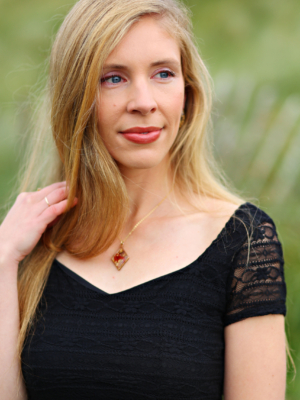Scarifying
I’m in bed. The house is silent, no one’s here but me. Me and my demons. Don’t think of what most scares you, I tell myself. Don’t let fear invade you. Of course, I know the pink elephant trick: my mind instantly wanders back to my most haunting ghosts. Tonight it’s an eerie scene from a murder mystery I watched. Silly me, why do I keep doing this to my hyper-sensitive hippocampus? I don’t feel safe, I want to run away. And yet I find myself freezing under the sheets. Listening for a sound, anything to make me jump. I breathe, focus on my inner strength as I learned in therapy. I wriggle my arm free from the blanket and look at the pale underside. Remember how I got here.
* * *
In the early 1500s, a group of flagellants whip themselves on the market square in Wittenberg. A man on the brink of becoming famous for reforming the church is the centre of attention, his back flaming red from the lashes of the whip. He doesn’t care that the Pope banned this practice more than 150 years ago. The clerics in town eye him with suspicion. He poses a threat to the hierarchy of the Catholic church, displaying himself here, surrounded by both men and women who publicly punish themselves for their sins, their innate impurity. This man doesn’t exclude the powerless. Instead, he invites women as equals to join him in this act of faith. It’s as if he’s saying that women, too, have the right to wear scars as a symbol of their trust in God. With every lash of the whip, the flagellants come one step closer to inner peace and wisdom, and to Heaven itself.
* * *
My skin isn’t half as scarred as I feel inside. But every volcano explodes once in a while, when the pressure becomes unbearable, and lava bubbles to the surface. I was asked only once how I got the scar, my most visible one. It’s not an obvious mark, let alone the numerous fine, feathery strokes surrounding it. I was careful to leave just one embodiment of emotional pain. To stay sane, I needed proof that horrible things had happened to me. I had never experienced physical violence, and yet there I was, bruised and broken mentally. I was stuck in my own head, trapped in a reality that ripped me of any sense of agency. Cutting myself proved to me that I had a body. A powerful and brutal body. A body that could act. One neat and narrow line on the ulnar region of my forearm, an area that is not often exposed. Whenever people notice, though, and I’m speculating here, I fear they know right away from the precise incision what I’ve done, and their lips become seals. Language propels wounds into existence, silence shoves them under the skin.
* * *
During the late nineteenth century, the “needle girls” spread across Europe like a virus. In Paris, for instance, a young middle-class woman retreats to the bedroom, day after day. She sits on the cold bed and pricks her skin with sewing needles. After a while, her husband can’t bear the sight of her punctured chest, the scarred arms, blotchy thighs. And what will the neighbours say, his family. He can’t afford to lose his reputation. He takes his wife to the doctor, who diagnoses hysteria and prescribes bedrest. Deprives her of the corset of chores. Takes away her needles. And so she wanders about during the day, when her husband is at work, borrowing a sewing kit from her neighbour. This woman understands, her skin patterned by needle stitches as well. The women share the needle, rip the pain in half, and double the screaming marks.
With more obvious mutilation comes poverty. The poorhouses in England are long used to seeing men and women with chopped off legs, arms, hands. Trying in vain to remove pain and suffering by cutting off the parts that seemed to carry the darkness. Society didn’t question their behaviour; it merely looked the other direction, widening the wound of suffering.
* * *
The only person who asked me about my scars was a child. She was eight years old, and I babysat her and her siblings. What happened to you? She wanted to know. It wasn’t an easy question to answer. Looking into the child’s innocent eyes, I shoved away my memories and said I’d cut myself on a sharp nail sticking out of a wall in my grandparents’ house, they’d used it to tie the clothesline. She believed me—I was impressed with my vivid imagination. Does it still hurt? She asked. I shook my head, not sure if that was the whole truth. But I kept wondering, what had actually happened to me that I did this to myself?
At her age, I suffered from terrible fits of rage that exploded me into a million pieces. One time I trampled on my beloved teddy bear until he was all crumpled and deformed. I cried for hours after I realised what I had done to something I loved so much, too much. With the horror that came over me after, I refrained from harming anything or anyone but myself.
At her age, I suffered from terrible fits of rage that exploded me into a million pieces. One time I trampled on my beloved teddy bear until he was all crumpled and deformed. I cried for hours after I realised what I had done to something I loved so much, too much. With the horror that came over me after, I refrained from harming anything or anyone but myself. To let out the anger pulsating in my blood, I slapped myself in the face until my cheeks were burning. They were always back to my usual pale complexion the next day. When that wasn’t possible, I scraped my nails over my thighs until the scratch marks turned from red to a throbbing white. Then I’d calm down, enough to leave my room and have dinner with my parents.
Later, in my teenage years, slapping and scratching couldn’t suffocate the pain anymore. I felt pushed around by my father, mother, and boyfriend—in that order—to comply with their visions for my life, for who I should be. I had my own dreams and desires, engraved in red ink in my locked diary. Nobody knew about them. Nobody believed in my dreams. What was worse, my father had a personality disorder, which caused him to sway from the softest lamb to a bloodthirsty wolf without rhyme or reason. If I didn’t tiptoe around him, I was easy prey. I was constantly under pressure to fulfil his erratic expectations, but my temper couldn’t keep quiet. After getting into fights with the father I so loved and hated at the same time, I’d tear the scissors across my forearm and leave a cut only so deep that my arm wouldn’t bleed. Grazes that would heal and turn into the palest scars, barely visible. I didn’t want to make a mess, be an attention seeker. I hid the arm in long sleeves, even in the summer, until the red crusts disappeared. One night my mother caught a glimpse of my arm in the bathroom, and her words cut me so deep that I reached for the scissors again: Don’t feel so sorry for yourself.
The dam fully broke on the night I refused to go to bed before ten pm. I had just turned eighteen and didn’t think to obey my father anymore. He shouldn’t have control over me. I acted up: Oh boy, relax. My father didn’t relax. He threatened to butcher me. Slit my throat. His words fell on the most fertile ground for developing PTSD; he’d planted seeds and raked and watered that ground long enough. His genetic material swimming in my own DNA certainly didn’t help. That night, I did it. With all the force I could muster up, I took the scissors and slit my forearm open. The cut was deep, blood gathered, and drop by drop it rolled down, hit the bathroom tiles. Then I took a picture with my flip phone, captured my inner torment embodied in the wound. A sense of immense peace and calmness spread through my body, my heart rate slowed down. It was the last time I cut myself: when I moved out, I went to therapy and slowly began to heal my inner and outer wounds. Still, I needed a crutch: I bit on lemons and chilis, sprinted until my lungs nearly burst, froze under a cold shower until my rage stopped burning. Eventually, as I processed my trauma, the desire to harm myself waned.
* * *
In 1914 England, an elderly woman lies down on her bed and cuts her throat with a razor. She loses consciousness quickly. Her last thought is of God, praying for redemption. Her little granddaughter, eight years old, finds her sleeping in a lake of blood. The girl is terrified, and the woman taken to hospital. There, the doctors refuse her emergency care as she attempted suicide, a crime according to the law at that time. The Victorian condemnation of self-harm and suicide threw long shadows into the twentieth century, stigmatising those in inner pain. The nurse demands that the police charge the woman with attempted murder. The officers don’t know what to do with the bleeding woman, so they leave her to the neglectful care of the medicinal staff. Two days later, she dies in the hospital, fulfilling her last wish.
* * *
An ex-boyfriend of mine, a scientist, examined my body like his lab samples. He penetrated me in every position and angle, licked my body from head to toe, plugged his fingers in all the holes, but he never asked me about the scars. Perhaps they had gone so pale and subtle by then that he didn’t notice, distracted by my boobs and bum. Or maybe the clean-cut lines were so obvious that he preferred to ship around the topic. Don’t cut too deep, stay on the surface, keep it casual. On our second date, I gathered all my courage and began to talk about my family. Before I could go into detail, he stopped me by saying he didn’t like to dive into depressing matters. In that moment, I knew we wouldn’t work out.
We still ended up being together almost two years. Two years of fighting, breaking up, getting back together. Two years of not feeling good enough, denying myself, moulding myself into a person who could be loved, until I burst out of my corset and ruined the illusion.
We still ended up being together almost two years. Two years of fighting, breaking up, getting back together. Two years of not feeling good enough, denying myself, moulding myself into a person who could be loved, until I burst out of my corset and ruined the illusion. Why did I stay with this guy? I think I didn’t want to be alone with myself, and besides I was secretly in love with someone else who was much older and married. I was so ashamed of myself, of my crooked emotions, that I kept going with this relationship out of pure guilt. Rarely, when the fights got ugly and left me feeling completely worthless, I thought of cutting myself again, but my boyfriend’s disdain towards my true self, and my unrequited love for the other man, were punishment enough to keep me from using the scissors. I merely reached for them, held them in my hands, soothed by the possibility of digging the cool, silvery blades into my skin.
* * *
In today’s America, a teenage girl’s arm is marked with sixty straight, parallel cuts. When she’s overwhelmed, she’s like a pressure cooker that needs to let off steam. She never goes anywhere without her kit, a little purple case with a pack of sharp razor blades, scissors and a pink towel. As soon as the pain kicks in and the blood flows, she feels a sense of peace and calm. She used to cut herself three times daily, when her stepdad was still living with them, but she’s limited herself to a few times per week now. She’s trying to stop because she’s aware that her behaviour isn’t considered normal. Her arm is a horrendous sight to the eyes of anyone but herself, she knows this. And yet, every cut tells a story of relief. She wonders how she can ever let something go that has saved her from wanting to die.
* * *
A few years later, I fell in love hard and hopelessly again. This time, that man requited not my love, but my lust. With all the desperate love I felt, I longed to confide in him, but he wasn’t interested in my past. He saw me as the physical being I’d needed so much proof of, saw my body as alive, as sensual and flawless. With him, I wasn’t stuck in the dark corners of my mind. His admiring gaze invigorated me—and I wanted more. I wanted all of him. But he told me he didn’t do relationships, that he was scared of going deep. And so I kept quiet, took everything from him I could get. I even let him stroke my biggest scar after sex, despite my urge to scream at the sensation. It burned me on the inside, the touch of his finger on a scar that, although outwardly fading, kept growing on the inside. Squinting and squirming, I distracted myself from his touch, fantasised his tenderness towards my stigma was his way of showing me he loved me after all. Eventually, he left me via text, and all I wanted to do was kick open his front door, curl up crying in his lap and tell him the truth. Tell him all my wounds and scars. In the end, I told him nothing. I just went partying with a forced smile on my face, visor down, neckline down, sleeves down, looking for someone else who could make me feel alive.
* * *
In Ethiopia, a young Suri girl has just had her first period. To mark her becoming a woman, her tribe performs a ritual: the women gather around her, sing, and scar the delicate skin on her belly by lifting it with a thorn and slicing with a razor blade. The girl’s lips are pressed together in pain, she sweats and pants under every cut, but she doesn’t cry. Her face is an image of courage. Months later, she wears an elaborate pattern across her upper body, in the shape of a cross. She made it through the agony of the ritual, proving that she’s strong enough to make it through childbirth, and truly any kind of pain. The young men in her tribe find her scarring beautiful. Sometimes, the boy she has a crush on traces her cross with his fingers, making her shiver. But the girl hasn’t forgotten the pain, it was her rite of passage into womanhood. She’s happy that she made her mother proud. Thinking she could have a daughter one day, her stomach sinks, but her lips crease into a smile.
* * *
I have recently broken my silence. I confessed to my sister, the only person who knows about my cutting past, that I have another intentionally created scar crawling across my belly. I lied to her for years about how I accidentally dropped my shower gel, which then cut through the skin at such a sharp angle that it left a scar. Back then, she believed me. She was only a child, unaware of the extent of the spite and loathing I directed at myself. The empathy in her eyes at my revelation made me squirm with guilt. I don’t deserve pity, let alone compassion.
The other day, I came across an article saying that the Eokoi of Nigeria see scars as money paying for the way to afterlife. Counting my scars, I can’t say I’d be rich in that sense, and neither would I be poor. I’d have some resources to fall back on, serving me as fare to my next life. I left cutting behind a long time ago, and yet I always found ways to hurt myself. I wanted punishment so badly, and I now can’t exactly remember what for. It helps that I’ve been single for over a year. More importantly, I’m not madly in love with a man who’s emotionally unavailable. I’m on my own, settling into my own skin, although too tight and itchy at times. At least the blood doesn’t fire through my veins anymore, it’s flowing like a calm, steady river.
* * *
I’m still in bed, looking at my arm. The underside is snow-white and vulnerable. For the first time I’m tracing the scars with my index finger. Goosebumps spread across the skin. There’s a lump in my throat, threatening to choke me. Old fear and new fear. Past pain and future pain. Certain of the latter. A blink of the eyes, droplets gaining traction. Not sure if I’m laughing or crying, I ask my scars to take me to my life after scarifying myself. Breathe. On the brink of falling asleep, my locked diary appears in my mind’s eye. I open it: I can see them, all my dreams, still ahead of me.
Christina Hennemann is a poet and writer based on the West Coast of Ireland. Her poetry chapbook, Leafing, won the Cerasus Poetry Prize (2024). Her second book, Witch/Womb (BookHub Publishing, 2024), was funded with an Agility Award from Arts Council Ireland. She received the Nassau Review’s Doyle Award for creative nonfiction and won the Luain Press Poetry Prize. Her work appears in Poetry Ireland Review, Poetry Wales, MORIA, Meetinghouse, and elsewhere. She is currently working on her debut novel. Learn more at www.christinahennemann.com






